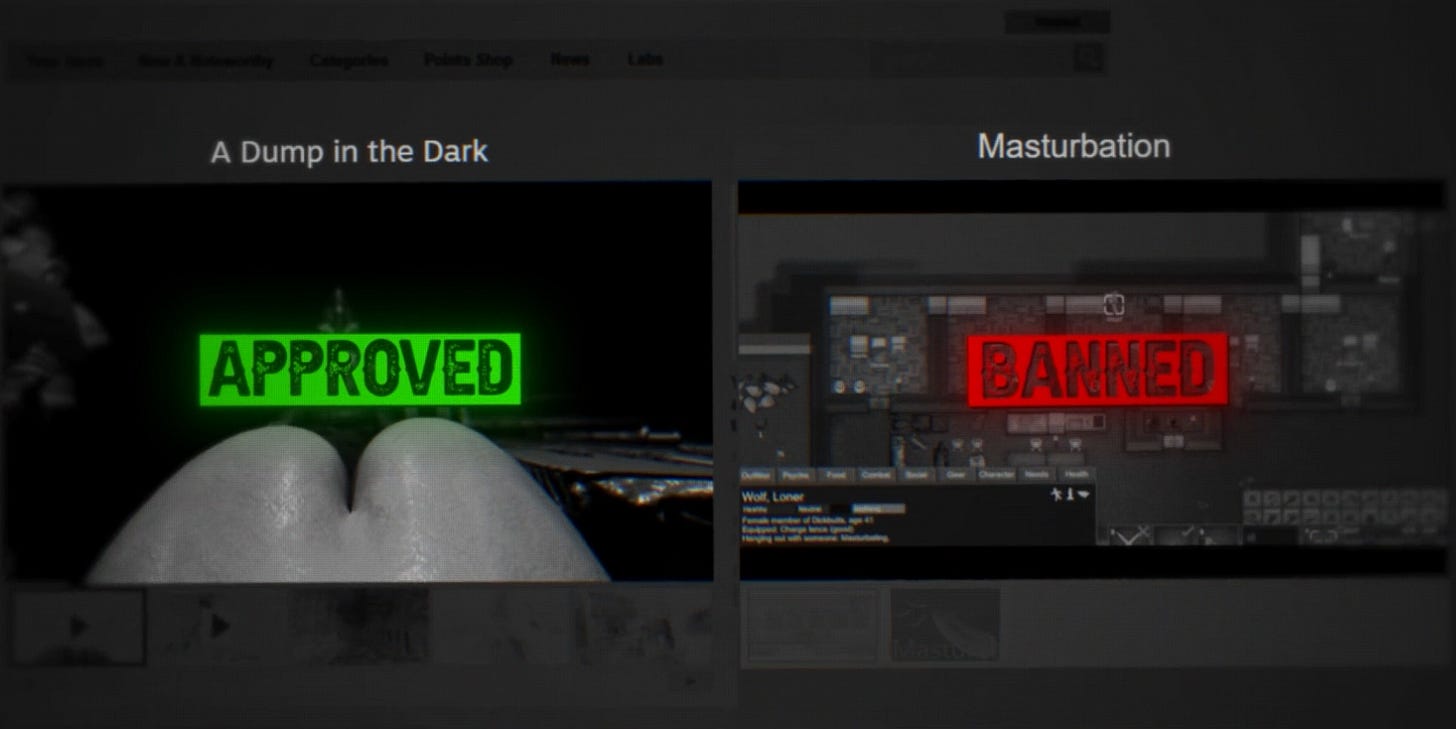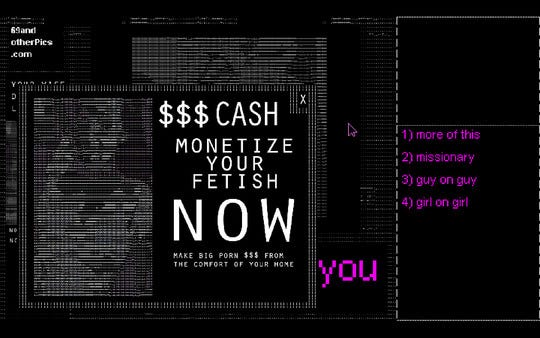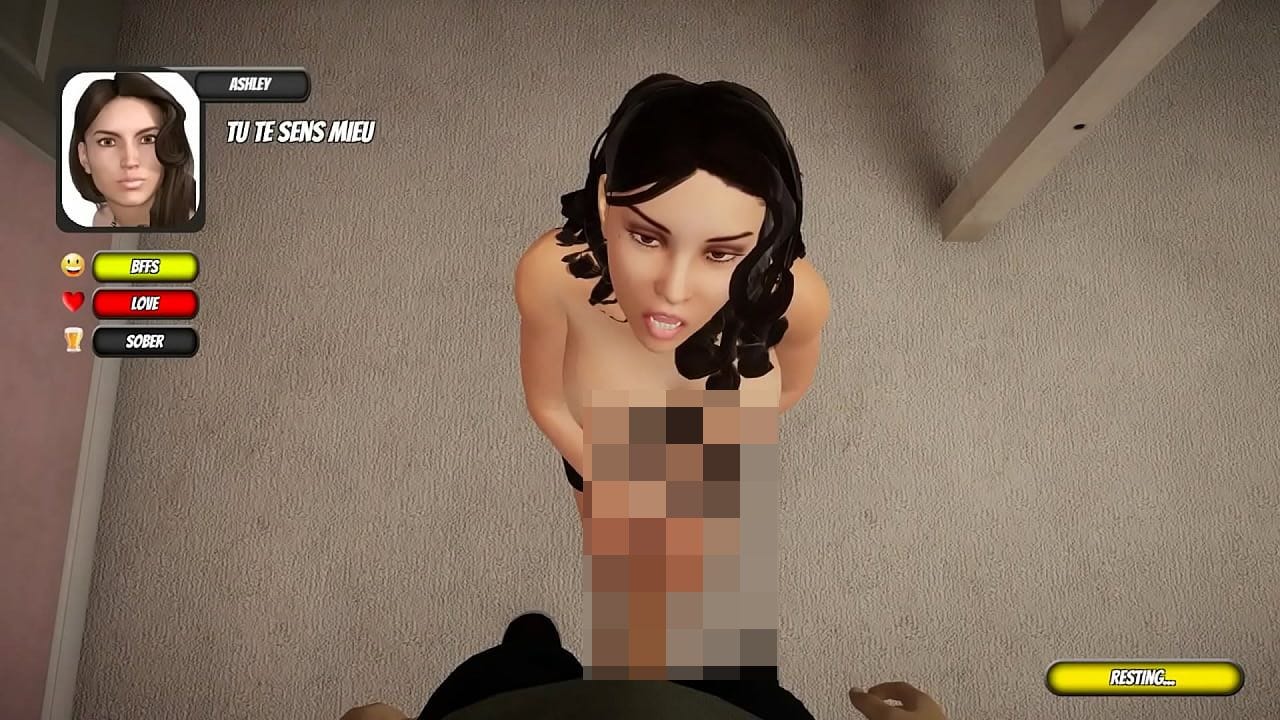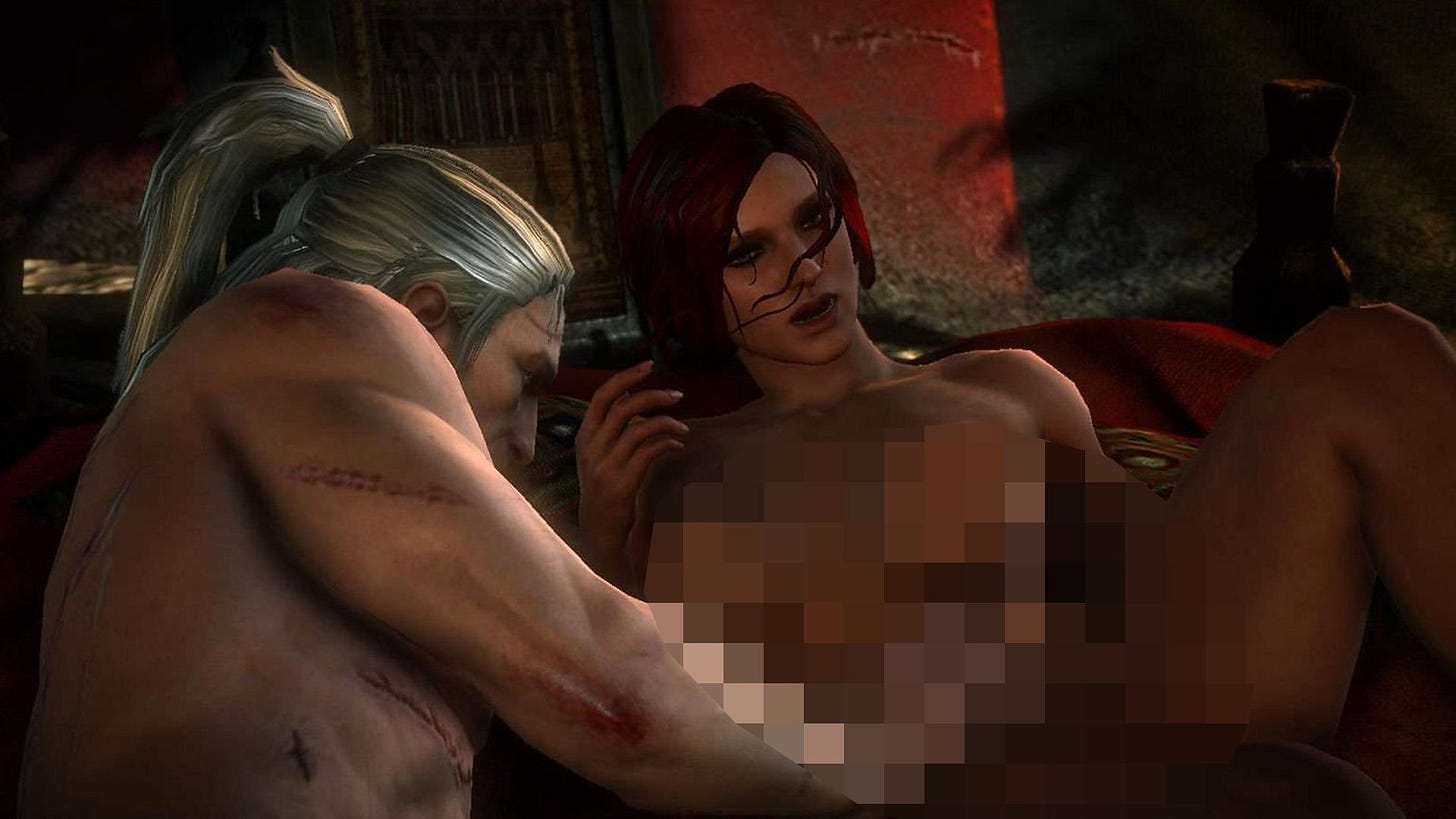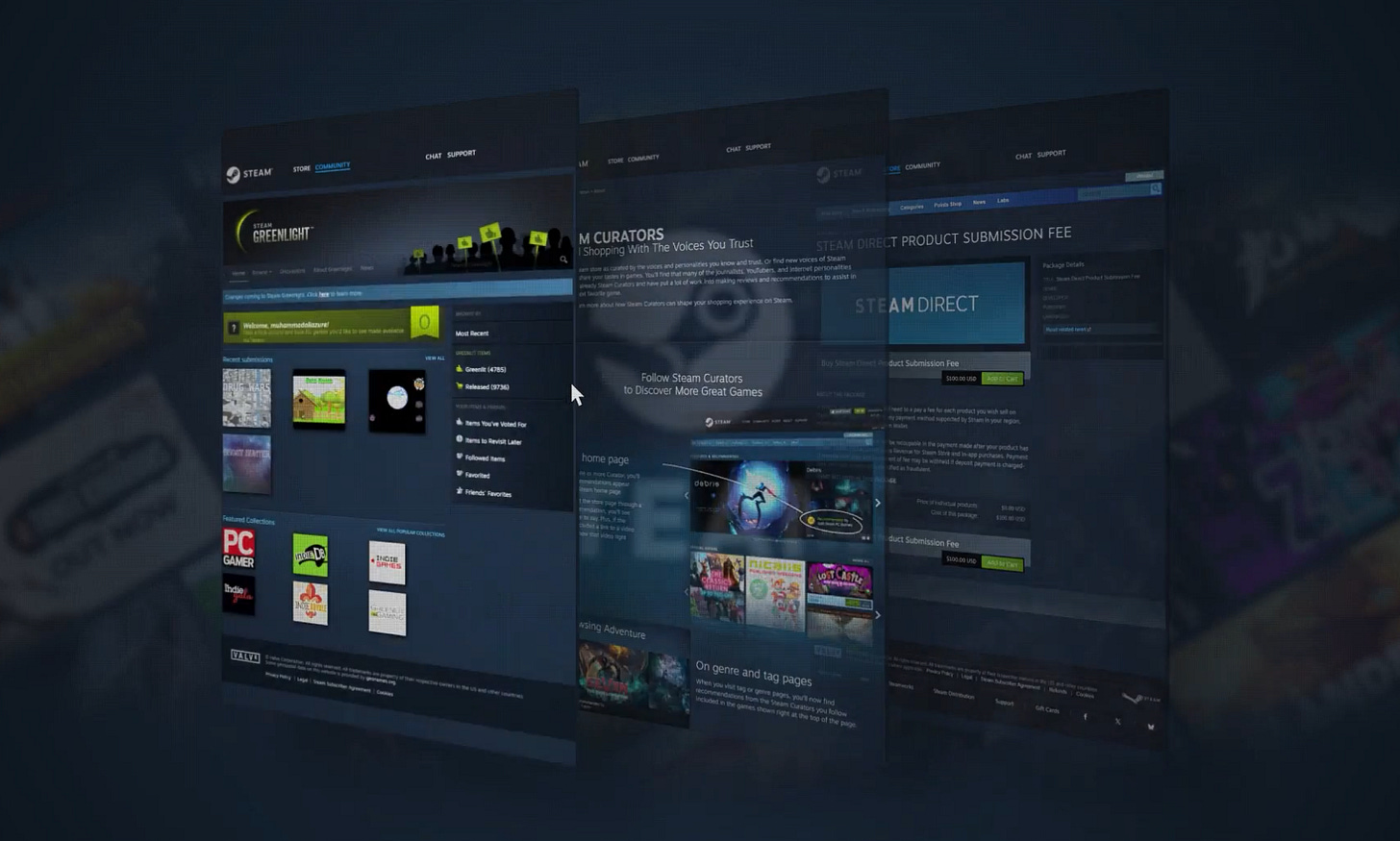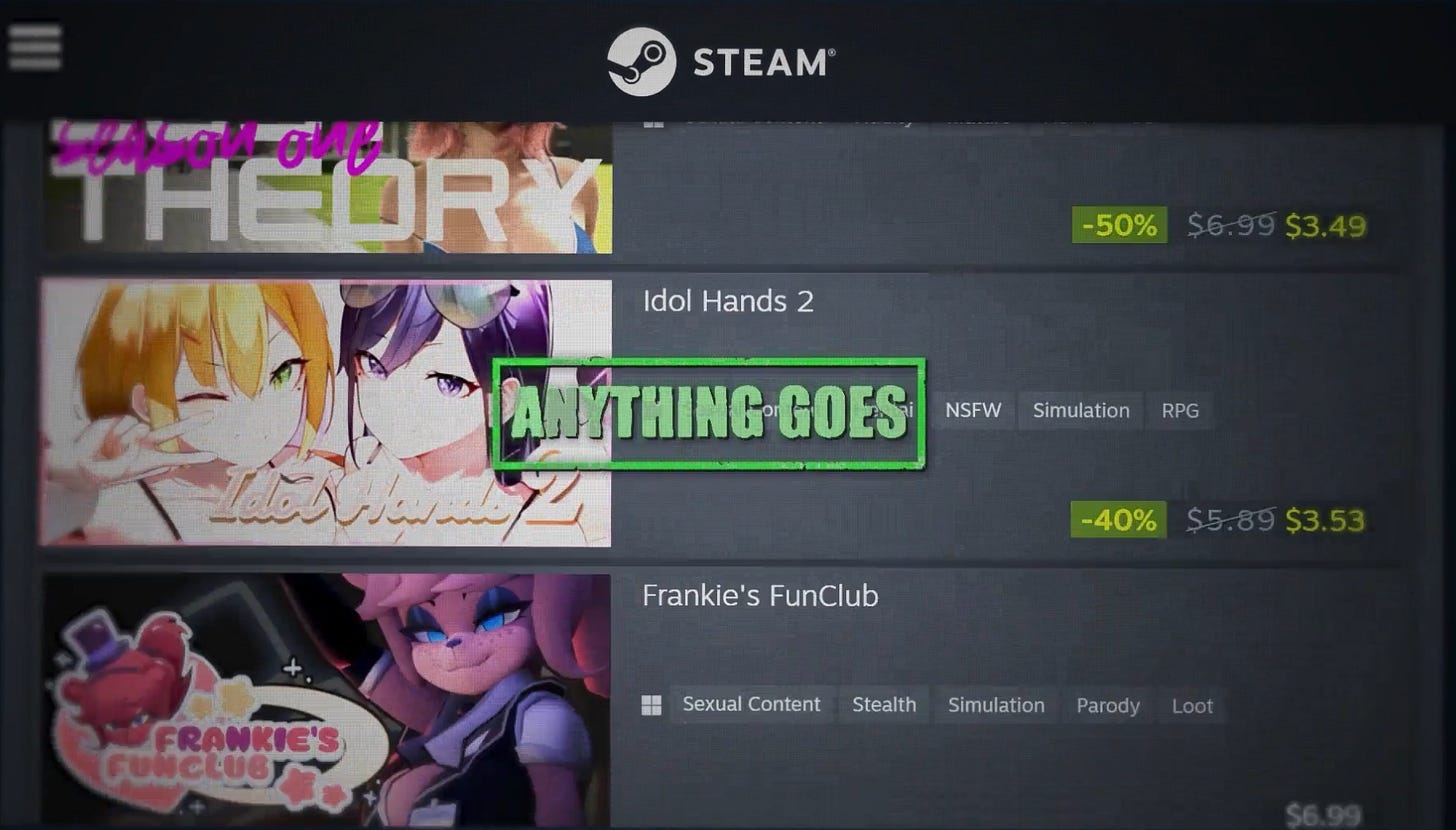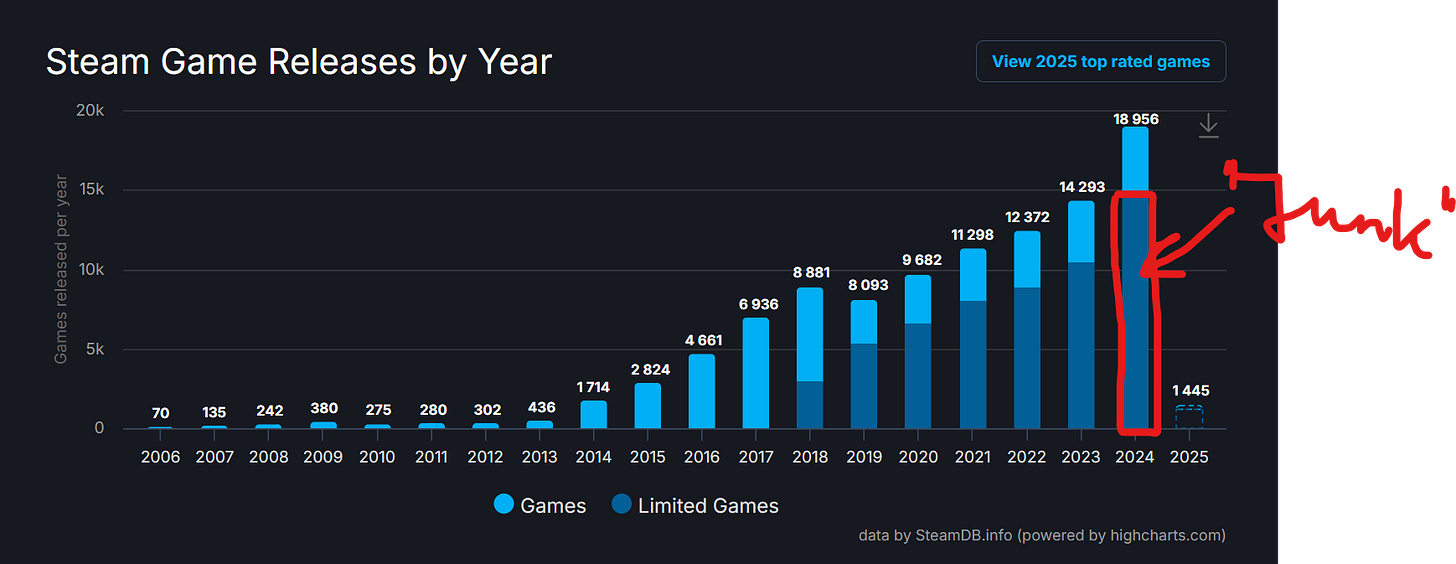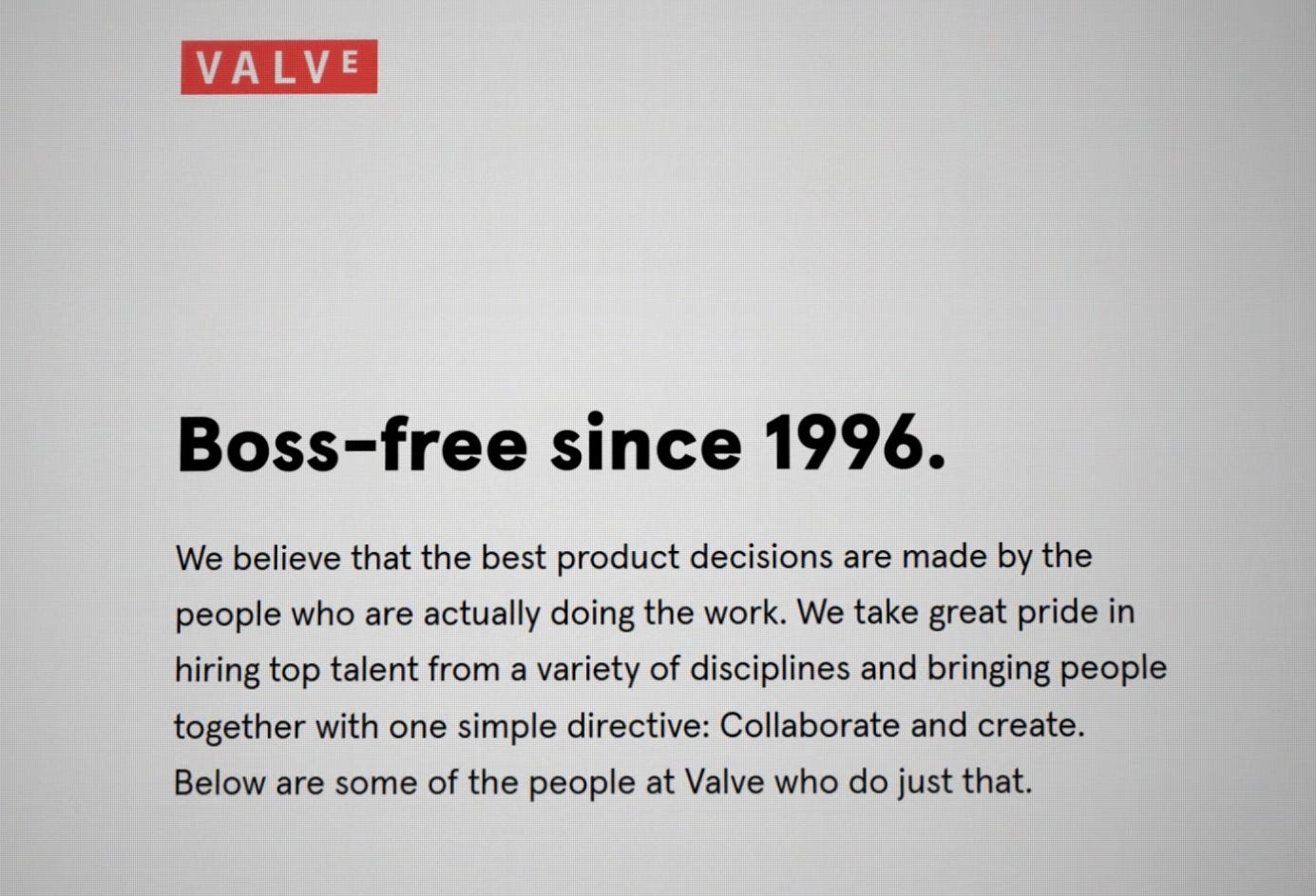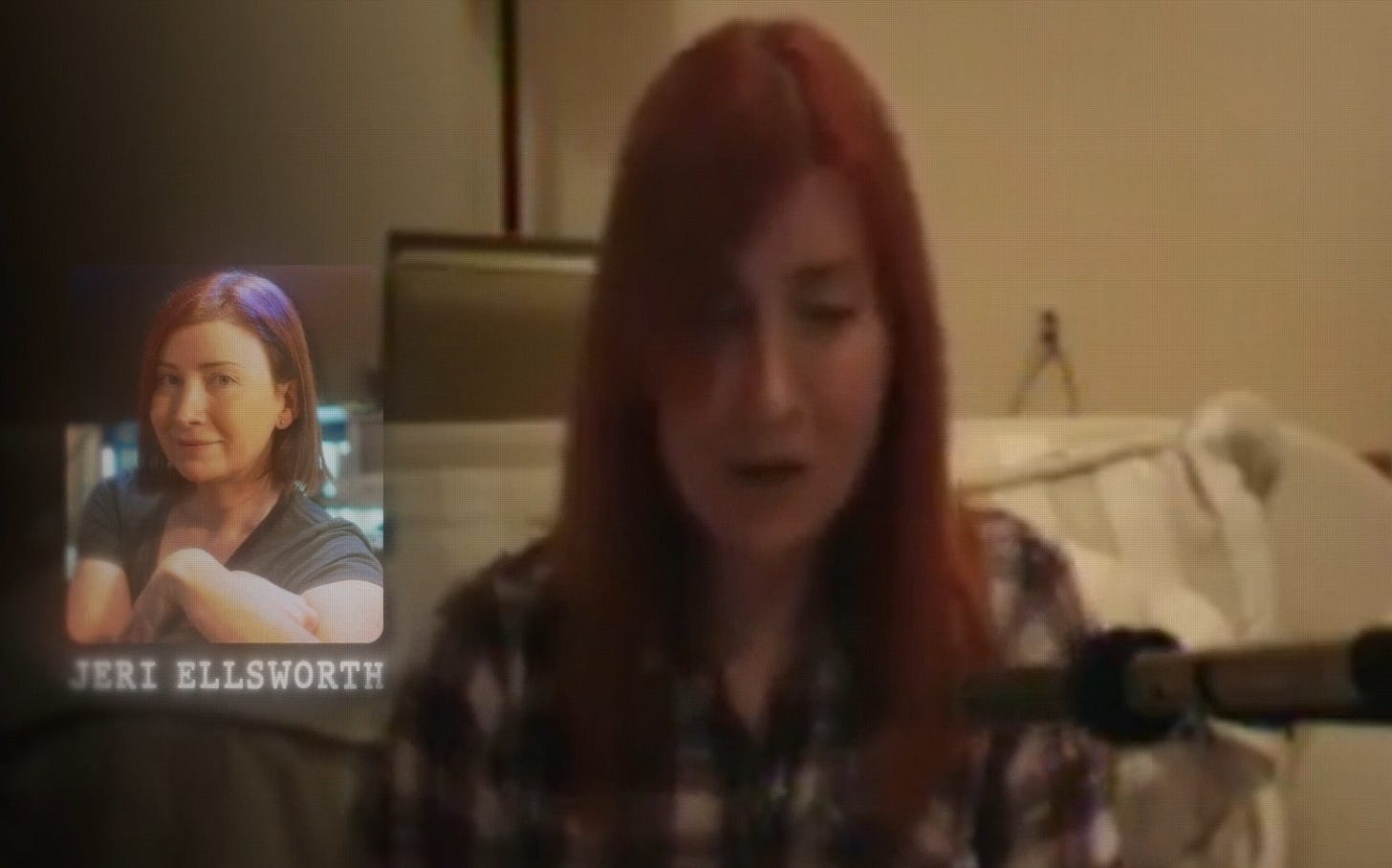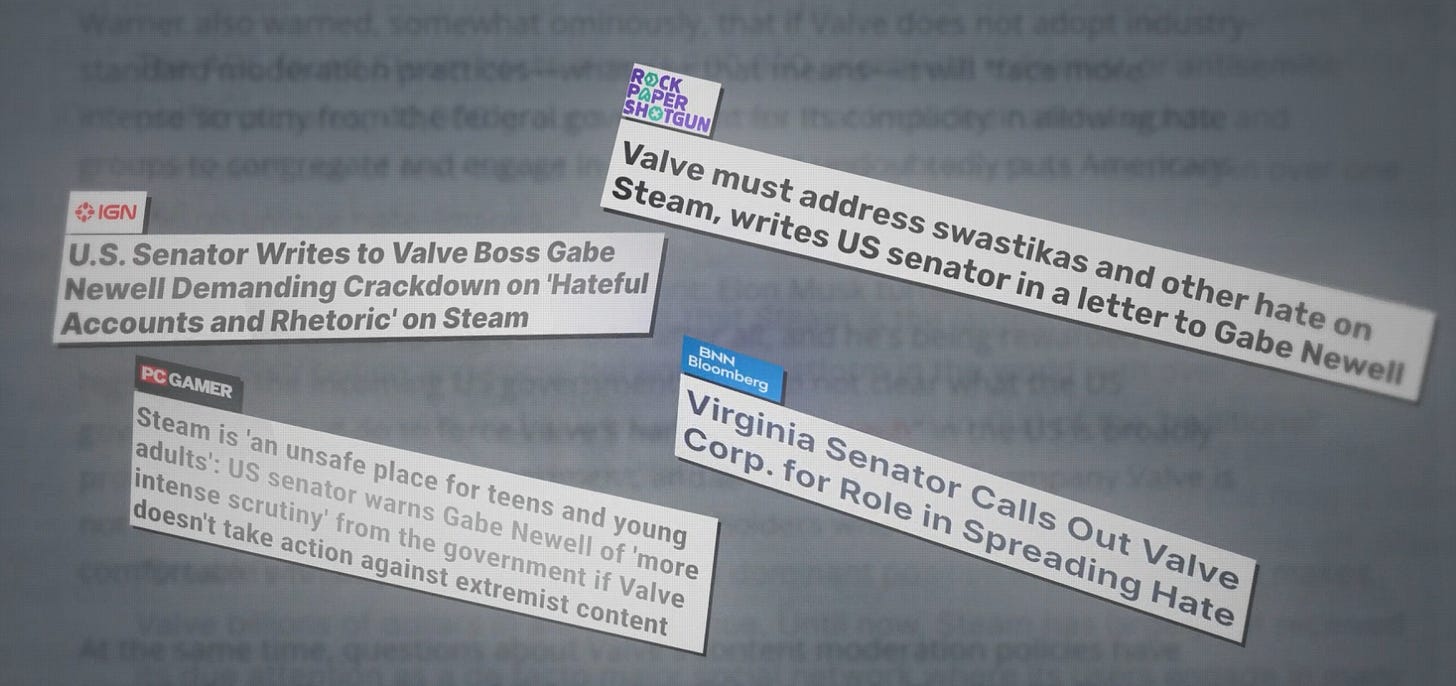Why Steam's Game Bans Are a Total Joke
A game about rape is OK - but not a game about pickup lines...
Why can a game with butt cheeks pooping on enemies stay on Steam, but a Rimworld patch where characters jerk off in private gets banned?
Why is Putin, Boobs and Trump off-limits , but Fuck Putin, Stalin and Hitler gets the green light?
Why is Blood Trail, the “most violent game in VR,” okay, but Tormentor isn’t?
And why is this, this and this, a game about rape, allowed, but a game about pickup lines gets rejected?
Well, my fellow Informed Gamers, welcome to Steam’s bizarre world of moderation where logic goes to die. Valve’s vague policies on what is and isn’t allowed has baffled everyone for years. From wrongly banned mods to asset-flips and shovelware, Steam’s inconsistent moderation is a well-known issue. But what’s less known is why it’s so utterly broken.
To understand why, you need some context. Steam isn’t just a platform—it’s the Amazon of PC gaming, and for small developers, it’s the only way to survive. But publishing on Steam feels more like Russian roulette. Valve, the company behind it, is infamous for its vague, ever-changing rules. One minute they ban “pornography,” the next they allow “everything,” only to then ban those again that feature “real-life explicit images.” The rules don’t just shift—they contradict.
It’s so bad, even politicians a re calling out Steam’s “hands-off approach to content moderation” that allows users to glorify Nazism, white supremacy, and school shooters. Valve technically banns hate speech, they just don’t enforce it, which is why a lot of Nazi content stays up unless governments like Germany step in.
For a billion-dollar company this powerful, you’d expect a system that works. So why doesn’t it? To find out, we need to look back at where it all started—when Valve first struggled to police its own platform. Spoiler: it didn’t go well.
You Must be 18 or Older to Enter
Steam’s moderation mess blew up in 2017. Suddenly, a game about a boy’s first look at adult themes vanished from Steam—not for gore or violence, but for harmless ASCII art that kinda looked like porn. For Steam, it definetely was porn. “If the game had monsters, or violence, or death, it probably wouldn’t have been banned,” said the developer, who was forced to put his game up on lesser known platform (Sorry Gamejolt)
Then came House Party—a game you win by having sex with women at a party. Blackmailing with drunk photos, whipping your dick out, or getting chicks drunk was all part of the gameplay. No surprise, it got pulled after it was publicly slammed for how “easily available” it was “to an estimated 35 million children.” But when the outrage cooled, the game sneaked back on Steam—toned down but still sketchy, with an off-Steam patch to restore the original.
And Steam seemed to be totally fine with the patch…
Meanwhile, Strangers in a Strange Land, a point-and-click that’s more peep show than puzzle game, got banned for too much skin and an underage-looking main character. But, surprise! It came back with giant “CENSORED” signs slapped over the risky parts. And just l llike House Party, there was a yet another patch to bring it all back. Steam’s response? Crickets.
The list of bans didn’t stop there. In 2018, Valve nearly removed Hunie Pop for pornographic content. The dev called it the "anime titty holocaust,” which saw Valve later admitting the warning was a mistake. But the trouble didn’t stop there. Other devs got hit with the same random threats, leaving everyone confused and frustrated. But Valve apologized for everyone of those and walked it back, leaving developers wondering what the next game was on Steam’s chopping board?
Porno Studio Tycoon, maybe? Surprisingly, no. While other games were banned way less, Porno Studio Tycoon—a game about building a porn empire—sailed through just fine. Sure, it didn’t have explicit nudity, but it was loaded with sexual sounds and barely dressed characters.
And yet, Steam never raised an eyebrow.
So how is it that smaller devs risk getting banned for a bit of pixelated skin, while the likes of The Witcher or GTA get a free pass? Because Steam’s rules were never about fairness…
Third Time’s Not the Charm
Enter Steam Greenlight, curator pages and Steam Direct - Valve’s weird attempts to clean up the chaos. Spoiler: it didn’t work.
It all started with Steam Greenlight in 2012, where players voted on which games deserved a spot on the platform. The idea? Let the community decide. The reality? A flood of low-effort submissions, spam, and a popularity contest that buried smaller devs.
It just didn’t work, and so, Valve replaced Greenlight with Steam Direct, a new system for devs to publish games on Steam for $100 fee. It was supposed to filter out the junk. Instead, it just opened the floodgates to shovelware and asset flips.
And then there were Curator Pages - the worst of them all. Those Curator Pages were meant to give “trusted voices” like YouTubers and gaming journalists a platform to recommend games. In theory, it would guide users to quality titles - in practice, curators just started spamming generic, paid reviews or copy-pasting store descriptions.
Some didn’t even play the games.
Worse, curators racked up thousands of fake followers through giveaways, which turned the system into basically a free-game farm.
All this to say that Valve just heavily relied on user reviews, to separate the good games from bad ones. But instead of fixing the cracks, Valve doubled down and came up with its boldest “fix” yet: an “anything goes” policy for games. Spoiler: it didn’t go well.
Anything goes…
In 2018, Valve finally stopped pretending they had control. After their previous attempts all flopped, Valve rolled out their mega solution to it all: the so called “anything goes” policy. The idea? Let everything in—except what’s “illegal” or “straight-up trolling.” Valve framed it as a commitment to freedom, saying, “We shouldn’t be choosing what content you can or can’t buy.” In reality? They were ditching all responsibility for curation.
The result? More shovelware. More asset flips. And, of course, more adult content. Valve didn’t just allow sex games—they built tools to help you filter them, adding an Adults-Only toggle and essentially telling players, “You deal with it.” Which might be fine... until you remember Steam’s filters are notoriously glitchy.
And what was meant by “trolling” really? One post described it as “crudely made software barely passing as a functioning game.” It’s a definition so vague, it created loopholes big enough to let in everything from Hentai Puzzle to Boobs Battleground.
And the numbers say it all: of nearly 19,000 games launched on Steam last year, over half were “Limited Games,” a label Valve uses to describe low-effort junk without calling it low-effort junk.
But it wasn’t just shovelware clogging the store. Games like Rape Day, which let you sexually assult women during a zombie apocalypse, made it to Steam. Only when advocacy groups accused Gabe of “profiting off of gamified sexual violence,” only then did Valve ban it, citing “unknown costs and risks.” It was just another PR fallout that Valve didn’t want to afford.
Anyways, despite its new “anything goes” policy,” Valve still couldn’t resist playing whack-a-mole and removed 170 “game-shaped objects” like Hentai 2048 - for whatever unknown reason. Once Valve removed the game Hatred, for whatever reason, only for Gabe to later apologize, saying, “It wasn’t a good decision.” For whatever reason.
Now, to understand why this keeps happening, you need to understand two parts. The first part is Steam’s approval process. It’s where the chaos starts. Spoiler: It’s a nightmare.
Steam’s Approval Process
So you wanna publish a game on Steam, yes? First, you have to sign an NDA to keep everything frustratingly opaque confidential. Then have $100 ready to join Steam Direct. Then, you need to set up your storefront page, which has its own seperate review process, to approve tags like “Adult content or “Gore,” and since Steam doesnt’ require ESRB or PEGI ratings, those tags are vague at best. “Adult Content” could mean nudity, excessive gore, or… who even knows.
After that comes the actual game build review. If Steam finds a problem, they’ll reject it with almost no explanation. Devs are left guessing what needs fixing, leading to endless resubmissions and delays. Players don’t know any of this, so when a release date mysteriously shifts, guess who gets the hate? The devs, of course.
On top, Steam relies heavily on its community to flag problematic content. Players can flag everything from store pages, in-game content, forums... The more flags, the faster moderators review it. But that system usually backfires because what one group finds offensive, another might see as perfectly fine.
But that’s just one part of the story. The second part as to why we have this chaos starts within Valve itself. Spoiler: It’s as flat as it can get.
Welcome to Flatland
“Welcome to Flatland. Valve is flat. We don’t have any management, and nobody “reports to” anybody else. We do have a founder, but even he isn’t your manager. The company is yours to steer. You’ll decide what to work on. You have the power to green-light projects. You have the power to ship products. Any time you interview a potential hire, ask yourself if they could literally run this company, because they will be. You were not hired to fill a specific job description. There’s no rule book for choosing a project. At Valve, nobody has an actual title. We take on the role that suits the work in front of us. Everyone has to function as a “strategist,” which really means figuring out how to do what’s right for our customers. We do not have a growth goal. We don’t make growth decisions based on external pressures.
These aren’t startup slogans. They’re direct quotes from Valve’s Employee Handbook—a “leaked” manifesto to promote the company’s infamous flat org structure. It’s from 2012, but still so current, it feels like the actual roadmap to their ongoing chaos.
Being “Boss-free since 1996,” Valve sounds like a utopia for creatives - no managers, no titles, just freedom to work on whatever you like. Sounds great in theory, but in reality, it’s chaos wrapped in good intentions.
Jeri Ellsworth, a former Valve employee, revealed that this structure works great when you’re “20 people.” But it does “break down terribly when you look at a company of 300 people.” Then it all just becomes “pseudeo-flat,” with an actual “hidden layer of powerful management,” that “felt a lot like high school,” where the “popular kids” are calling the shots.
And when a few popular kids are calling the shots at a “boss-free” company, you also have a moderation process where one person can single-handedly decide which games get banned. That’s how “Mary” became infamous in the Visual Novel community—banning Evenicle 2 for its content while Evenicle 1, nearly identical, stayed on Steam, likely reviewed by someone else.
Her copy-pasted rejection message even resurfaced word-for-word in bans like Tenshi Souzou. Which only meant one thing: moderation at Steam is more about who reviews your game than any consistent policy.
But it gets worse: Did you know that employees receive bonuses tied to their projects’ profitability? Meaning, if a project isn’t a safe bet, no one’s gonna work on it. Why risk your bonus on something experimental when you can stick to sure things like Steam’s cash-cow marketplace?
Remember when Valve tried to let players sell mods for Skyrim, sparking outrage over monetizing a tradition? Well, luckily they scrapped the idea within days but Gabe’s response to this fiasco said it all: “Actually, money is how the community steers work.” A comment that perfectly sums up Valve’s mindset.
And now you know why Steam keeps banning the wrong games. With 300-ish employees, Valve is running the world’s largest highway for PC games, but doesn’t want to account for the traffic. They’ve built a highway where anything can speed but without proper regulations. And when crashes happen - whether it’s a banned game, offensive content, or shovelware - it’s never their problem.
Valve calls this “freedom.” But freedom without accountability isn’t freedom - it’s chaos. And for a platform this massive, that chaos comes with real consequences. Developers lose their livelihoods. Gamers lose trust. And the industry? It inches closer to more government oversight, lawsuits, and even more bad press.
The good news is: Valve could fix it, if they really wanted to. It’s not rocket science. The approval process needs rules—actual rules—clear, public, and consistent ones. No more guessing games for devs. They could bring in AI moderation, hire dedicated staff, and stop letting random employees decide a game’s fate.
And that “flat structure?” Well, it sounds cool, but let’s be real - it’s not working.
Valve doesn’t need a CEO in every cubicle, but they do need accountability. Give bonuses to teams that also take risks, not just to the people sticking to safe bets. Valve has the money, talent, and influence to fix this. They could set the standard for how gaming platforms should operate.
But will they?
Well, if Valve’s history has taught us anything, it’s this: they love a good cliffhanger. Spoiler: this might just be one they never resolve.
Happy Steaming!


